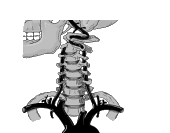Note that some links will break as pages are moved, websites are abandoned, etc.
If this happens, please try searching for the page in the Wayback Machine at www.archive.org.

Adverse events associated with spinal manipulation. Regarding neck manipulation, the risk/benefit ratio for the procedure appears to be in question due to the availability of safer options.
NOTE: In the UK, there appears to be no publicised national system for reporting adverse events related to chiropractic treatment. Furthermore, the UK General Chiropractic Council's current promotional literature appears to make no mention of serious risks.
Related links
A 34-year old man in previous good health was admitted following acute left-sided loss of coordination, dysarthria, and hypo-aesthesia following neck manipulation by a chiropractor. Neuroradiology (May 2003) [Reported in FACT]
"A-38-year-old man suddenly developed nausea, vomiting and vertigo during chiropractic neck manipulation. This was followed by right hemiplegia, right deep sensory disturbance and left hypoglossal nerve palsy, consistent with the medial medullary infarction (Dejerine syndrome). The MRI revealed infarction at left medial part of the medulla. The vertebral angiogram and MRA showed marked narrowing of the left vertebral artery. X-rays of the cervical spine showed no spondylosis, dislocation nor osteolysis of the odontoid process….. The mechanism was suggested that rotation and tilting of the neck stretches and compresses the vertebral artery at the cervical joint causing injury to the vessel, with an intimal tearing, dissection, and pseudoaneurysm formation. Consequently, the present case may be caused by injury to the left vertebral artery with an intimal tearing during neck manipulation sufficient to cause disection and subsequent infarction of the brain stem." No To Shinkei (February 2003) [Japanese article]
"It is now a well established fact that cervical thrust manipulations can harm the vertebral artery…This problem is now better known. It is no longer attributed to atherosclerosis (and ageing process) but to a dissection of a vertebral artery, a clinical entity observed in younger patients (20-45 years)." Recommendations of The French Society of Orthopaedic and Osteopathic Manual Medicine (SOFMMOO) (2003)
Patients undergoing Spinal Manipulative Therapy should be consented for risk of stroke or vascular injury from the procedure. Neurology (2003)
In a survey among 240 neurologists, neurosurgeons, rheumatologists and physicians aimed at estimating the frequency and the incidence of strokes, myelopathies, radiculopathies or osteoarticular accidents linked to spinal manipulation during the preceding two years, the incidence of vertebro-basilar accidents was 30 times higher than in published series. Annales de Readapatation et de Medecine Physique (2003)
German neurologists report the case of a 40-year-old woman who had a chiropractic upper spinal manipulation and immediately afterwards suffered increasingly severe symptoms of intracranial hypotension, e.g. headache, nausea and vomiting. After considerable diagnostic confusion a dural tear was found at the level of C1-C2. There were no other causes for the leak of cerebro-spinal fluid. The authors are thus certain that this is the first well-documented case of intracranial hypotension caused by chiropractic. They also speculate that a substantial amount of cases of 'spontaneous' intracranial hypotension may be related to upper spinal manipulation. Journal of Neurology, Neurosurgery and Psychiatry (2003)
Conclusions: Cervical spinal manipulation therapy may worsen preexisting cervical disc herniation or cause disc herniation resulting in radiculopathy, myelopathy, or VA compression. In cases of cervical spondylosis, CSMT may also worsen preexisting myelopathy or radiculopathy. Manipulation of the cervical spine may also be associated with higher complication rates than previously reported. Neurosurgical Focus (December 2002) [pdf]
"The results of this study suggest that stroke, particularly vertebrobasilar dissection, should be considered a random and unpredictable complication of any neck movement including cervical manipulation. They may occur at any point in the course of treatment with virtually any method of cervical manipulation." Journal of Neurology (August 2002)
Concludes that serious complications of cervical spine manipulation appear to occur regularly. Their incidence is essentially unknown and should be established as a matter of urgency through adequately designed investigations. E. Ernst, The Medical Journal of Australia (2002)
"Specific risk factors for vascular accidents related to spinal manipulation have not been identified, which means that any patient may be at risk, particularly those below 45 years of age." Edzard Ernst, Canadian Medical Association Journal (2002)
Includes a statement of concern to the Canadian public from Canadian neurologists regarding the debilitating and fatal damage manipulation of the neck may cause to the nervous system. Concern No.5 strongly recommends "the immediate banning of all spinal manipulation of infants and children". Brad Stewart, MD, Chirobase (2002)
Concludes that there appears to be a causal relationship between carotid artery dissection and chiropractic manipulation of the cervical spine. Klin. Monatsbl. Augenheilkd. (2002)
Spine (2002)
Three cases of stroke due to arterial dissection following chiropractic manipulation are presented. Cerebrovascular Diseases (2002)
"Acute, painful Horner's syndrome as a manifestation of vascular dissection may be associated with chiropractic manipulation of the neck." American Journal of Ophthalmology (April 2001)
"Practitioners of this technique (cervical spine manipulation) should be called on to demonstrate the evidence-based benefit of this procedure and to define the specific indications for which the benefits of intervention outweigh the risk." Stroke (2001)
Concludes that concern about neurological complications following cervical spine manipulation appears to be justified. Journal of the Royal Society of Medicine (2001)
"….one must consider underreporting: if a patient suffers a serious complication after spinal manipulation, her chiropractor is unlikely to see her again, and the physicians who do might not think of a link between manipulation and the adverse effect. And even if they consider an association, are they likely to publish this as a case report? Moreover, none of the prospective studies available to date have enough power to detect events that occur less frequently than 1 in approximately 500 patients." E. Ernst, Stroke (2001)
Concludes that, although uncommon, diaphragmatic paralysis from phrenic nerve injury can be a complication of cervical chiropractic manipulation. CHEST (2001)
Concludes that serious cerebrovascular complications of spinal manipulation continue to be reported. Their incidence is unknown. Large and rigorous prospective studies are necessary in order to define the risks of spinal manipulation accurately. E. Ernst, Physical Therapy Reviews (March 2004) [The Full Text version of this article has recently become subscription-only. In the Case Reports section (Table 1) of the Full Text version, 11 cases are listed where a chiropractor was the therapist involved in administering cervical spine manipulation in which the CAUSALITY of the adverse event is listed as 'CERTAIN'. In two of these cases (Corazzo 1998 and Siegel 2001), the adverse event was vertebral artery dissection and stroke].





